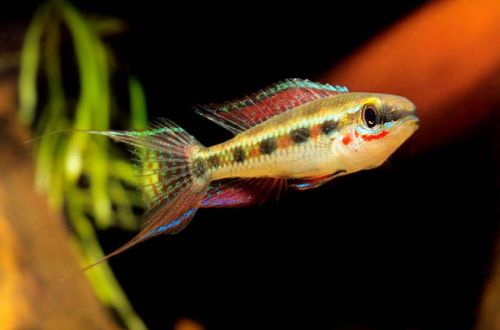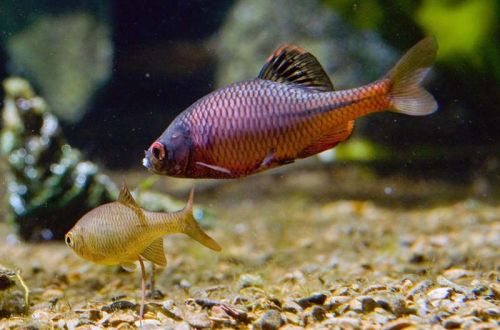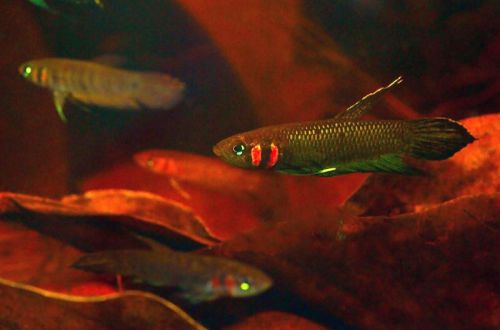
Loricaria red
Loricaria red, belongs to the genus Rineloricaria, family Loricariidae (Mail catfish). The exact species affiliation has not been established. There are several versions of the origin of this form. According to one of them, it is a breeding variety or hybrid of the Peruvian Loricaria (Rineloricaria lanceolata), according to another, it is one of the as yet undescribed species classified as L010a and L10a.
In any case, scientific disputes about the exact identification of this catfish do not affect the features of its maintenance in aquariums and are unlikely to be of great interest to beginner aquarists.

Contents
Habitat
The catfish or its ancestors, if it is a hybrid, comes from the tropical part of South America. Inhabits the vast Amazon basin. It occurs mainly in shallow streams and rivers on a sandy bottom among plant debris (leaves, branches, snags).
Brief information:
- The volume of the aquarium – from 60 liters.
- Temperature – 24-29°C
- Value pH — 6.0–7.5
- Water hardness – soft to medium hard (2-15 dGH)
- Substrate type – sandy
- Lighting – subdued
- Brackish water – no
- Water movement – light or moderate
- The size of the fish is about 11 cm.
- Nutrition – any sinking food with herbal supplements
- Temperament – peaceful
- Content singly or in groups
Description
Adult individuals reach a length of about 11 cm. Catfish has an elongated slender body, the outer covers resemble chain mail – they consist of separate segments. The head is triangular in shape with a sucker-shaped mouth. The fins are large, each ray of which ends with a spike. Body color is brick red-brown.
It should be noted that such coloring was not found in catfish living in the wild, which indirectly indicates the selection origin of the color.
Sexual dimorphism is weakly expressed. Males can be distinguished from females by the presence of tiny bristles on their heads called odontots.
Food
The daily diet should include high-quality dry, frozen or live sinking food with mandatory herbal supplements. For example, flakes, granules in combination with bloodworms, tubifex and other invertebrates.
Herbal supplements must be present either as part of the dry food, or served separately. A good choice would be blanched (boiled) slices of cucumber, zucchini, spinach, lettuce, cabbage and other green vegetables.
The catfish is unpretentious and will eat food leftovers left by other fish, or a raid of algae on the walls of the aquarium, design elements.
Maintenance and care, arrangement of the aquarium
The optimal size of the aquarium for a group of 2-3 catfish starts from 60-70 liters. The design is arbitrary, the catfish perfectly adapts to various conditions. However, it looks most harmonious in an environment that resembles a natural body of water with a sandy substrate interspersed with stones and many shelters made of driftwood.
Red Loricaria likes to dig in the ground in search of food, so it can accidentally damage aquarium plants. It is advisable to acquire species with a strong root system or plant them in separate pots, then immersed in the substrate.
Catfish is able to live in a fairly wide range of hydrochemical parameters, so water treatment is not required. In most cases, it is enough to defend the water and pour it into the aquarium. If kept together with other fish, it will successfully adapt to their pH and dGH needs.
Aquarium maintenance is standard, including a weekly replacement of part of the water with fresh water, which is convenient to combine with the removal of organic waste, and equipment maintenance.
Behavior and Compatibility
They are distinguished by a peaceful disposition, get along well with relatives and with most other species of comparable size. Corydoras catfish, goldfish, almost all viviparous, small Tetras, Danios, Barbs and many other popular species will become good aquarium neighbors.
Breeding / breeding
Breeding is simple if there is a heterosexual group of at least 6 catfish. These fish are very picky in choosing a partner. It is noted that if only one male and female are kept, they rarely form a pair.
Favorable conditions for spawning are slightly cool water, which will be 3-4 degrees lower than usual, and a diet rich in plant components. With the onset of the breeding season, the male chooses a place for future masonry – a cave or a grotto. Many breeders use ordinary PVC tubes with a diameter of about 5 cm. The male climbs inside and thoroughly cleans the surface. When the female accepts courtship, she lays several dozen eggs. After fertilization, the male stays next to the clutch to protect it. At this time, he may attack other fish to scare them away.
The incubation period lasts 4-5 days. It will take another 2-3 days for the fry to begin to swim freely. From this moment on, the male’s care ends and, on occasion, he can eat his own offspring. It is advisable to transfer the juveniles to a separate tank in order to avoid predation by other fish.
Fish diseases
In aquariums with a healthy ecosystem, proper nutrition, and the absence of threats in the form of aggressive fish, cases of disease are very rare. Symptoms of the disease will usually indicate management problems (injuries, poor water quality, poor feed, etc.). If the root causes are eliminated, then the body of the catfish can independently cope with the disease. Otherwise, medical treatment will be required, more details in the section “Diseases of aquarium fish”.





